Check out my custom vibration dampener
Wilson Blade 98 v8
In-depth Review & Playtest
We hope you love this article. Just so you know, TennisCompanion may collect a small share of sales from the links on this page to help keep this site running. Learn more. Disclosure: Wilson gave me this frame to evaluate, but they did not pay me to write this review or influence its contents.
One of the game’s most popular tennis racquets, the Wilson Blade aims to deliver best-in-class feel, control, and comfort.
For 2021, Wilson releases the Blade’s eighth generation, which continues to offer excellent all-court performance with a stylish new cosmetic and subtle refinements to the racquet’s tech.
Whether you’re on the hunt for your first racquet, making a switch to a new frame, or considering an upgrade, I share everything you need to know about the Wilson Blade 98 v8 so you can decide if it’s right for you.
Article Contents
Click below to jump to a section
Tap below to jump to a section
About the Wilson Blade
Specs & Technologies
Wilson Blade Models
Design & Aesthetics
Players Using
Strings & Tension
Review & Playtest Notes
Summary & Takeaways
Blade 98 Alternatives
New to TennisCompanion?
Create a free account and explore my latest videos below
Video Review & Playtest
Below you’ll find a companion video for this article, which goes in-depth to provide a visual walkthrough of the Wilson Blade 98 16×19 v8.
The video covers all the essential details to help you gain a feel for the racquet, from specs and technology to my on-court playtest that showcases the frame’s performance.
I’ve listed timestamps for each of the video’s sections to help you jump to any particular areas of interest.
- 0:28 Intro
- 0:45 Specs
- 0:56 Length, Head Size, String Pattern
- 1:16 Weight & Swingweight
- 1:39 Balance
- 1:53 Stiffness
- 2:00 Beam Width
- 2:13 Technology
- 2:24 Graphite + Basalt
- 2:34 FortyFive
- 2:44 Parallel Drilling
- 2:55 DirectConnect
- 3:04 Top Grip Taper
- 3:13 Ergonomic Butt Cap
- 3:16 Design & Aesthetics
- 3:58 Strings & Tension
- 4:47 Playtest & Review
- 5:07 Playtest Notes
- 5:14 Groundstrokes
- 5:52 Volleys
- 6:23 Serves
- 6:52 Returns
- 7:11 Summary
- 7:50 Wilson Blade 16×19 vs. 18×20
- 8:57 Wilson Blade 104
- 9:42 Wrap Up
For more in-depth coverage and review of the Wilson Blade 98 v8, check out the remainder of this article.
About the Wilson Blade Series
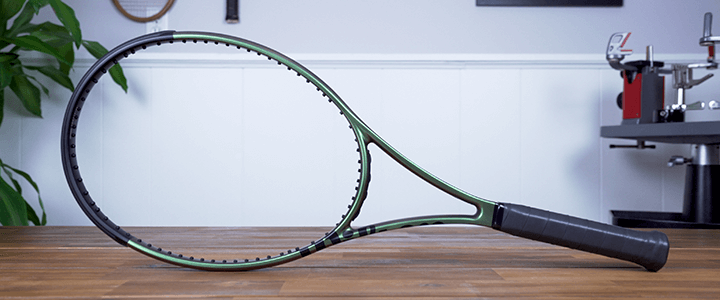
The Blade family of tennis racquets initially debuted in 2006 with the introduction of the nBlade, a black, orange, and white frame with a 98 square inch head and an 18×20 string pattern and specs that catered to strong intermediate to advanced players.
Now in its eighth generation, which officially launched in September 2021, here’s a quick look black at the various models of Blade tennis racquets over the years:
- 2006 – 2008: Wilson nBlade
- 2008 – 2010: Wilson (K)Blade
- 2010 – 2012: Wilson Blade BLX
- 2012 – 2015: Wilson Blade v4
- 2015 – 2016: Wilson Blade v5
- 2016 – 2019: Wilson Blade v6
- 2019 – 2021: Wilson Blade v7
- 2021: Wilson Blade v8
As you can see, the Wilson Blade has gone through several iterations. However, the essence or pursuit of the line has remained fixed on delivering exceptional feel and control and subsequently helped the franchise rack up an extensive list of endorsements, including the Williams sisters, Stefanos Tsitsipas, Simona Halep, and Milos Raonic.
As with many tennis racquets, some dedicated fans appreciate and long for the return of older models. However, like any manufacturer, Wilson strives to align the frame’s performance with the evolving game while doing its best to remain true to its roots.
You’ll find mixed opinions on how Wilson’s success, but the frame’s continued popularity and pervasive usage provide us with at least one indicator that suggests they’re on the right track.
As another point of context, the Blade line of tennis racquets has accumulated an impressive 36 total Grand Slam titles, and the Wilson Blade v8 will undoubtedly build upon the frame’s dominant legacy.
If you’re in the market for a new Blade, it’s worth noting that Wilson typically releases updates to their most popular tennis racquets every 2-3 years. If you’re reading this article, you can use that as a point of reference to determine when the next generation might release.
Why is the Wilson Blade so popular?
On tour, players often rely on lower-powered racquets with excellent feel, which allows them to achieve greater precision while tapping into their strength and technique to deliver power when needed.
The Wilson Blade fits this mold delivering a classic feel with modern enhancements, which drives its popularity among the game’s top athletes, competitive amateurs, and recreational players worldwide.
Beyond feel and control, another reason players frequently gravitate toward the Wilson Blade is comfort. Since its origin, the Blade family of racquets has aired on the side of lower flex or stiffness ratings, which helps reduce shock and vibration and aids comfort.
Comparing Wilson’s Performance Racquets
Wilson offers five core lines of performance tennis racquets with varying characteristics to appeal to a broad range of players.
Blade

The Wilson Blade is a modern take on the classic player’s racquets that delivers excellent feel and control with a flexible frame that doesn’t sacrifice too much power and delivers sufficient spin.
Pro Staff
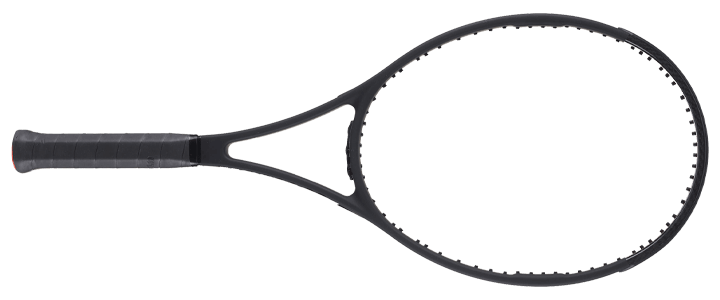
Like the Blade, the Pro Staff line delivers a classic feel through added weight, smaller head sizes, and a unique braided graphite construction that offers a bit less flex while enhancing feedback for precision.
Clash
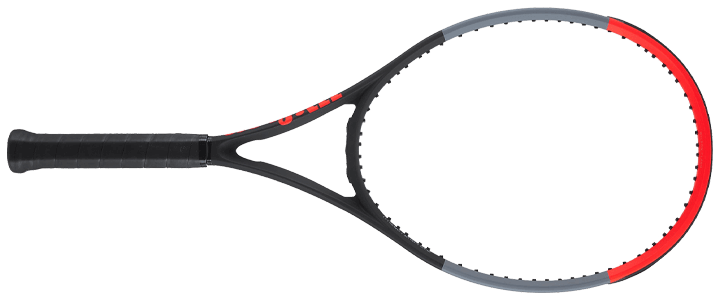
The most recent addition to their lineup, the Clash, is Wilson’s response to the growing demand for exceptional comfort without sacrificing responsive performance. This line of frames has larger head sizes for a bit of added power, spin, and margin for error.
Ultra

Well-known for explosive power, the Ultra line offers mid-range head sizes and lightweight, stiffer frames that cater to aggressive baseliners who demand exceptional spin.
Burn

A close, more affordable cousin to the Ultra, the Burn line of tennis racquets delivers excellent power while skewing towards maximum spin with mid-range head sizes, open string patterns, and lighter-weight frames that help players enhance racquet head speed.
Wilson Blade 98 v8 Specs & Technologies
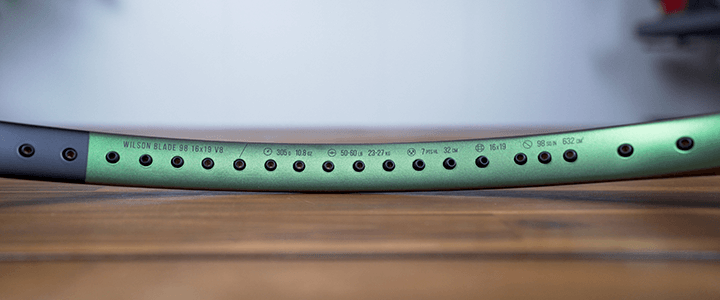
There have been smaller incremental tweaks to the Blade’s specs, materials, and design throughout its existence.
However, for the most part, Wilson doesn’t stray too far from one version to the next because they want to avoid distancing themselves from existing users who are most likely to upgrade.
With that in mind, you’ll notice that the Wilson Blade 98 v8’s specs don’t differ all that much from its predecessor. Below you’ll find a comparison of the v7 and v8 Blades.
| Spec | Blade v7 | Blade v8 |
| Head Size | 98 in² / 632.26 cm² | 98 in² / 632.26 cm² |
| Length | 27 in / 68.58c m | 27 in / 68.58c m |
| Strung Weight | 11.4oz / 323g | 11.4oz / 323g |
| Unstrung Weight | 10.8oz / 305g | 10.8oz / 305g |
| Strung Balance | 5 pts HL / 32.6 cm | 5 pts HL / 32.6 cm |
| Unstrung Balance | 7 pts HL / 32 cm | 7 pts HL / 32 cm |
| Swingweight | 320 | 328 |
| Stiffness | 61 | 62 |
| Beam Width | 21mm / 21mm / 21mm | 21mm / 21mm / 21mm |
| Composition | Graphite & Basalt | Graphite & Basalt |
| String Pattern | 16 Mains / 19 Crosses | 16 Mains / 19 Crosses |
| String Tension | 50-60 pounds / 22.7-27.2 kg | 50-60 pounds / 22.7-27.2 kg |
More broadly, specs help provide players with a rough expectation for the type of performance they can expect from a given racquet.
However, while they offer a valuable point of context, they don’t tell the whole story, so I always encourage players to demo a racquet before buying if possible.
With that said, the Wilson Blade 98 v8 comes in your standard length of 27 inches with a smaller 98 square inch head size, which reduces power and helps players retain control over the ball.
Wilson pairs the smaller head size with a 16×19 string pattern for spin, which I find ideal for this frame. It’s worth noting that there is also a tighter, more control-oriented string pattern of 18×20 available.
The frame’s advertised or expected unstrung weight is 10.8 ounces or 305 grams, which is on the mid to upper end of the spectrum and helps provide stability and power.

However, for reference, the frame I have on hand weighs in at just under 10.9 ounces or 308 grams, so expect a bit of variance.
When strung, the racquet’s weight will increase by 18 or so grams depending on your string of choice and its swingweight or how heavy the frame feels when swinging comes in at 320.
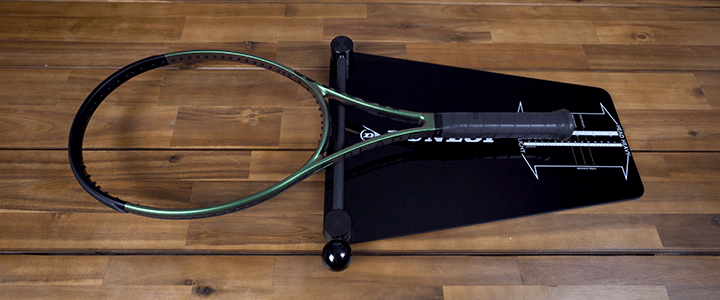
The Wilson Blade’s balance or distribution of weight throughout the frame is 7 point HL at 32 cm unstrung, which reduces slightly to 5 points HL at 32.6 cm with strings installed.

For its stiffness or flex, the Wilson Blade has a lower RA or stiffness rating of 61, which helps deliver excellent comfort.

Finally, the frame has a thinner 21 mm beam all the way around.
Wilson Blade v8 Technologies
For the 2021 Blade 98, Wilson introduces a handful of new technologies that set it apart from prior generations while aligning with the frame’s core performance characteristics.
However, before jumping in, keep in mind that while it’s helpful to learn about the intentions behind the tech, what matters most is how a racquet feels, so if possible, I’d encourage you to try or demo a racquet before buying to form your own opinions.
Braided Graphite & Basalt

Wilson Blade 98 v8 retains its braided graphite and basalt composition for optimal flex and feel, which lends itself to enhanced control.
FortyFive

Wilson rebrands the Blade’s prior generation FeelFlex technology as FortyFive, further enhancing the frame’s vertical and horizontal flex while retaining stability.
Parallel Drilling
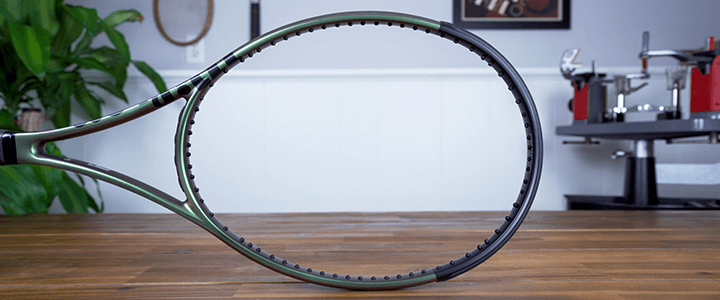
Within the racquet’s head, the Blade takes advantage of Parallel Drilling for select grommets, which increases the sweet spot’s size and results in a more forgiving response.
DirectConnect Handle

New for the Blade v8 is Wilson’s DirectConnect handle, which fuses the butt cap with the handle’s carbon fiber for a bit of extra stability.
Top Grip Taper
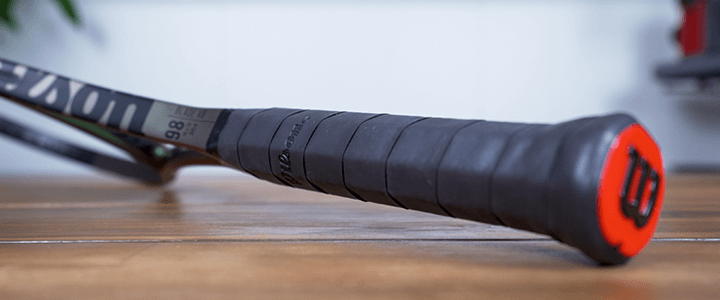
The frame continues using Wilson’s top grip taper, which improves feel for the top hand when hitting a two-handed backhand.
Ergonomic Butt Cap
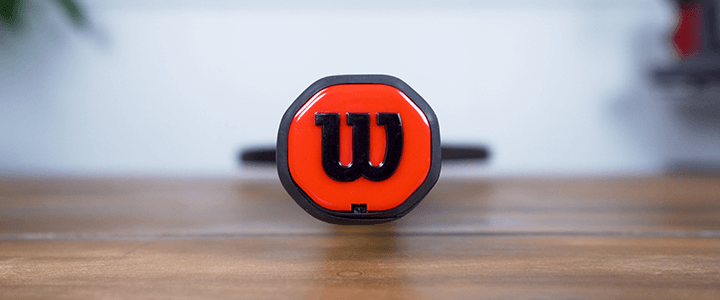
At the bottom of the Wilson Blade’s handle, the racquet’ features a red ergonomic butt cap with smooth rounded edges for added comfort.
Wilson Blade v8 Models
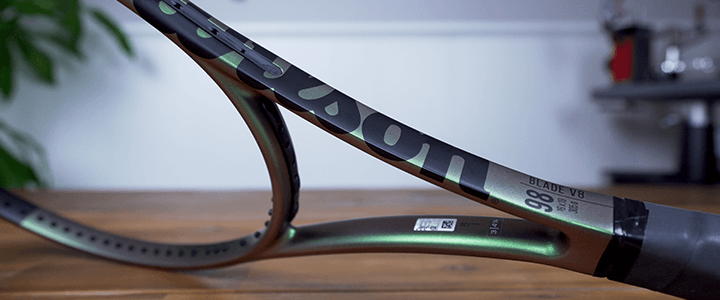
Like all of Wilson’s performance tennis racquets, the Blade family comprises various models that offer modified specs to cater to a broader audience while adhering to the line’s core principles.
Wilson Blade 98 v8 16×19
Within this line of tennis racquets, the Wilson Blade 98 v8 16×19 is the best-selling flagship model, which I reviewed for my playtest.
It’s a low-powered control-centric tennis racquet that offers excellent feel and comfort. However, its open 16×19 string pattern slightly boosts power and spin relative to its 18×20 sibling.
For most, this frame is an excellent starting point, which we’ll use as the basis for comparing the rest of the models in the Blade family.
Wilson Blade 98 v8 18×20
With nearly identical specs to the 16×19, the Wilson Blade 98 v8 18×20 has a tighter string pattern, which adds to the frame’s control and precision while resulting in a slightly firmer feel.
Experienced players who hit big, have flatter groundstrokes, and are looking to maximize their command over the ball will likely find what this frame has to offer appealing.
Wilson Blade 100 v8
Offering more power, spin, and forgiving feel, the Wilson Blade 100 is one of the latest additions to the Blade lineup.
Much of the frame’s difference in performance comes from its larger 100 in² (645.2 cm²) head size and 22 mm beam, which is 1 mm thicker than the Blade 98 models.
Despite being 0.18 oz (5 g) lighter than the Blade 98 models, it retains an identical 7 pt HL balance, which results in a similar swingweight.
Somewhat unique to this frame is that Wilson maintains a lower RA or stiffness rating rather than bumping it up for added power, which helps maintain a more consistent feel with the Blade 98 models.
Wilson Blade 100L v8
To help broaden the Blade’s appeal, Wilson offers a lighter version that weighs only 10.1 oz (285 g) unstrung, which helps improve the frame’s maneuverability for a more user-friendly option.
It’s worth noting that this model has a higher RA or stiffness rating at 69 and a slightly thicker beam at 22 mm to help increase power and compensate for the frame’s lower weight.
As a result, this model won’t provide as much comfort as those mentioned above. However, it’s still worth considering if the heavier weight of the other frames feels a bit too much to handle.
Wilson Blade 100UL v8
In 2021, Wilson adds an ultra-light model to the Blade lineup, which clocks in an unstrung weight of only 9.35 oz (265 g).
This new model makes an excellent option for younger players looking for an entry point into the Blade lineup and adult beginners or seniors needing an easy-to-swing racquet.
It comes in the standard length of 27 inches and has a 2 pt HL balance at 22.5 cm unstrung.
Wilson Blade SW102 Autograph
For years, Serena Williams relied upon the Wilson Blade 104 as her racquet of choice, but she was looking for a bit more control to complement her raw power.
After testing nine prototypes, Serena and Wilson landed on her signature model, which debuted in 2020. Most notably, the frame has a slightly smaller head size than her previous fame at 102 in² (658 cm²), which helps enhance control.
However, one of the unique elements of the frame is its extended length of 28 in (71.1 cm), which is a full inch longer than most standard racquets that usually measure 27 in (68.6 cm).
The racquet also features a thicker 22.5 mm beam, a higher RA or stiffness rating of 69, and a 7 pt HL balance, which positions more weight towards the racquet’s handle.
It’s worth noting that when releasing the new 2021 Wilson Blade line, Serena’s signature model retains its existing specs and distinct black and gold paint job.
Wilson Blade 104 v8
Although Serena no longer uses it, Venus continues playing with the Wilson Blade 104, which the pair helped make popular.
As the name implies, the racquet has a larger 104 in² (670 cm²) head size. However, you’ll also find it’s a bit lighter at 10.2 oz (290 g) unstrung, has a 9 pt HL unstrung balance, 22 mm beam, and the lowest RA or stiffness rating of the entire Blade line at 60.
Finally, the Wilson Blade 104 v8 offers an extended 27.5 in (69.9 cm) length for a bit of added reach and leverage.
Wilson Blade 98 v8 Design & Aesthetics

For better or worse, a racquet’s cosmetic or paint job significantly influences its adoption and where you’re virtually always guaranteed some modification from Wilson.
With that said, a racquet’s color is part of its brand, so more often than not, you’ll see Wilson change the design while maintaining a color scheme that allows players to identify a model quickly.
For a while now, Wilson has leaned into their simple matte color schemes, which offer on-brand consistency from one model to the next.
However, for the Blade v8, Wilson heads in a different direction with a unique chameleon-style matte paint job that’s dynamic and shifts between green and copper.

At the top of the hoop, you’ll find matte black and silver print highlighting the frame’s FortyFive construction, while all other print is black.
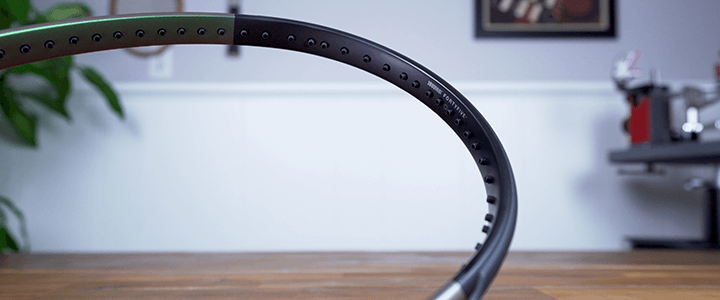
As far as durability goes for the paint job, I wouldn’t expect any significant improvements, but I do like how Wilson has broken the mold of their more recent racquet styles with something unique that stands out from the crowd.
Players Using the Wilson Blade Series
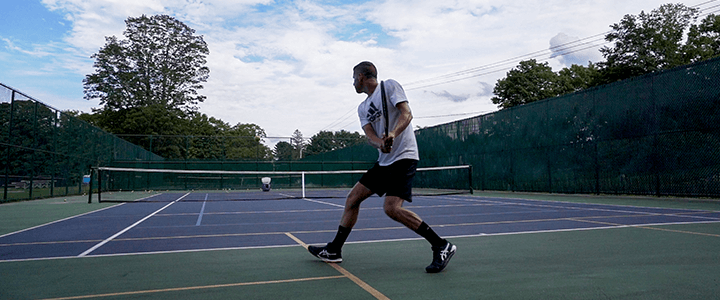
The Wilson Blade is one of the most popular tennis racquets on and off the pro tour, so you’re likely to see it around your local courts and on TV when watching some of your favorite players.
In some cases, the players you see will be using the exact model sold by Wilson. However, top players often use older versions painted to look like the latest generation, which is purely an endorsement.
Alternatively, some players will be using the latest generation with customizations to the racquet’s specs for personalization.
Regardless, it’s good to be aware that the frame you purchase will likely be somewhat different from the racquet you are buying with a few exceptions like the Wilson Pro Staff RF97, which is Roger Federer’s signature model and identical to the specs he uses.
Starting in August 2021, you’ll begin to see many of the players listed below using a racquet that looks identical to the Wilson Blade v8 as they transition to the new style frame.
| Men (ATP) | Women (WTA) |
| Alex de Minaur | Alison Riske |
| Aljaz Bedene | Aryna Sabalenka |
| Alexander Peya | Astra Sharma |
| Andrey Kuznetsov | Barbora Strycova |
| Blake Mott | Jelena Ostapenko |
| David Ferrer (retired) | Kateryna Kozlova |
| David Goffin | Kiki Bertens (retired) |
| Dimitry Tursunov | Laura Robson |
| Dudi Sela | Lauren Davis |
| Filip Krajinovic | Madison Brengle |
| Guido Pella | Margarita Gasparyan |
| Juan Ignacio Londero | Natalia Vikhlyantseva |
| Jiri Vesely | Nina Stojanovic |
| Karen Khachanov | Paula Badosa |
| Laslo Djere | Petra Martic |
| Lorenzo Sonego | Polona Hercog |
| Lucas Lacko | Sara Sorribes Tormo |
| Michal Przysiezny | Serena Williams |
| Milos Raonic | Simona Halep |
| Nicolas Mahut | Venus Williams |
| Norbert Gombos | Veronika Kudermetova |
| Pablo Carreno Busta | – |
| Pedro Martinez | – |
| Roberto Carballes Baena | – |
| Salvatore Caruso | – |
| Sebastian Korda | – |
| Stefanos Tsitsipas | – |
| Tennys Sandgren | – |
| Ugo Humbert | – |
| Vasek Pospisil | – |
Please keep in mind that players change racquets periodically, so I’ll do my best to keep this list up-to-date.
Of course, if you spot any inaccuracies, please don’t hesitate to drop a comment at the bottom of this article to let me know.
Wilson Blade 98 v8 Strings & Tension
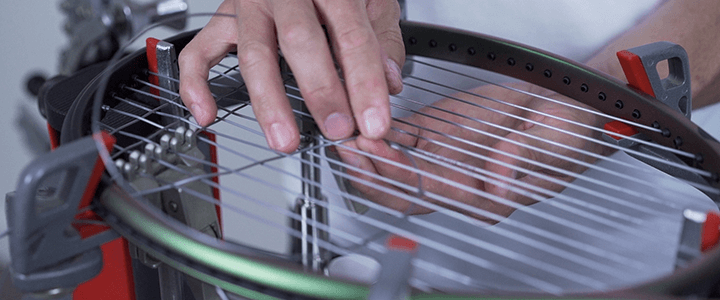
When stringing the Wilson Blade v8, the type of string and tension you choose will significantly impact the racquet’s performance.
Most manufacturers, including Wilson, will provide a recommended or optimal tension range based on real-life testing for their racquets. In addition, it’s common for companies to suggest one of their strings that pairs well with the racquet.
Wilson recommends Luxilon Alu Power for the Blade with a 16L or 1.25 mm gauge strung at 50-60 lbs (22.7 – 27.2 kg).
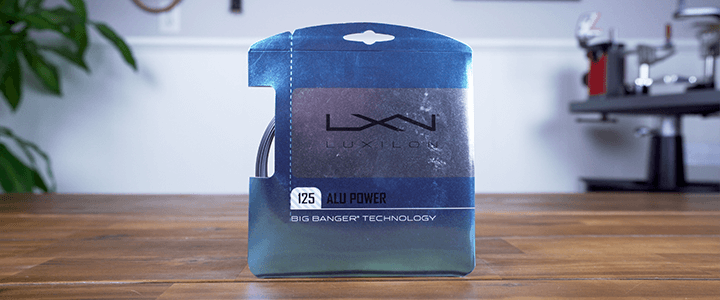
At first glance, it might seem odd that Wilson recommends Luxilon ALU Power. However, Wilson is the exclusive worldwide distributor of Luxilon, which is one of the many reasons they recommend it.
I agree that Luxilon is an excellent pair with the Wilson Blade, so despite the relationship and bias, I strung with 16 gauge or 1.30 mm ALU Power at 52 lbs or 23.6 kg for my playtest.
For context, Luxilon Alu Power is one of my picks for the best tennis strings and is a durable and low-powered polyester that delivers excellent spin, feel, and control.
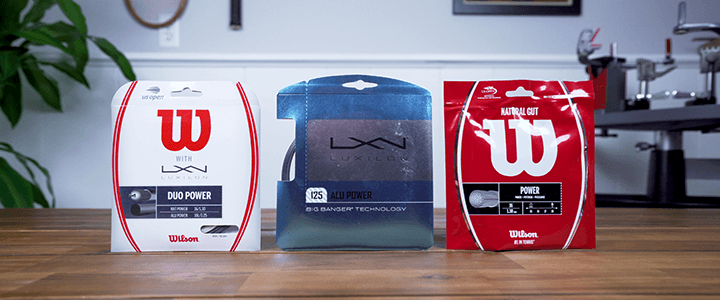
One of the string’s most significant downsides is comfort, so if that’s a concern, you might consider pairing ALU Power with a natural gut or multifilament for added comfort as Roger Federer does with his frame.
Wilson Blade 98 v8 Review & Playtest Notes
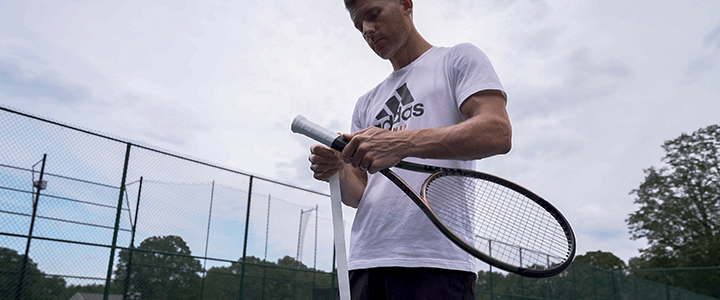
You can learn a lot by researching a racquet and becoming familiar with its background, specs, and technologies, but there’s no substitute for hitting with a frame to gauge its performance and feel.
To that end, I’ve thoroughly tested the Wilson Blade 98 v8 and rated its performance across a wide range of characteristics to help you gain a better understanding of what to expect.
If you have a demo program at your disposal, I hope my review helps you determine whether it’s worth your time.
Alternatively, if you don’t have access to try the Wilson Blade 98 v8 before buying, I hope you find my thoughts and experience helpful in making a decision.
For reference, I’ve included some playtest notes below that you might find helpful when considering my thoughts and opinions on the racquet.
| Main Strings | Luxilon ALU Power (1.25 mm) |
| Cross Strings | Luxilon ALU POwer (1.25 mm) |
| Mains Tension | 52 lbs / 23.59 kg |
| Crosses Tension | 52 lbs / 23.59 kg |
| Forehand Grip | Semi-Western |
| Backhand | Two-handed |
| Grip Size | #3 – 4 3/8 |
| Grip | Wilson Pro Performance |
| Overgrip | Wilson Pro |
| Weight | 165 lbs / 74.84 kg |
| Height | 6’0″ / 1.83m |
To help make my reviews more concrete, I rate each tennis racquet on a standard set of criteria, which you’ll find below for the Wilson Blade 98 v8. To learn more about why I gave these scores, be sure to check out my playtest notes in the sections that follow.
Groundstrokes
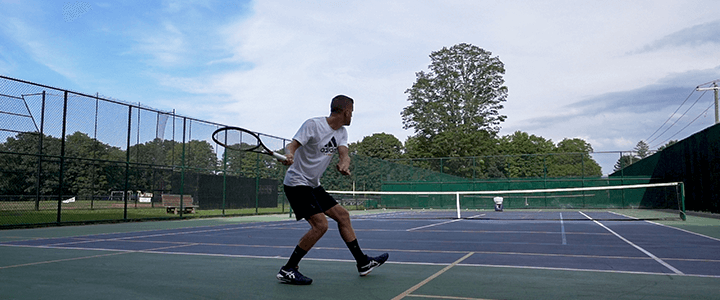
From the back of the court, I thought the Wilson Blade 98 was solid. Hitting groundstrokes, I felt a strong command over the ball, and because it doesn’t provide much free power, I rarely felt like I was overhitting or the ball was getting away from me.
I preferred the racquet hitting backhands, which is my flatter shot. However, it was plenty sufficient on my forehand with the open 16×19 string pattern delivering adequate topspin and the smaller 98 square inch head size, helping maintain excellent control.
Throughout my playtest, I found comfort to be one of the frame’s standout features. There’s no doubt it’s an arm-friendly racquet, which pays off as you open up your swing to generate power.
Volleys

Up at the net, I thought the Wilson Blade performed well. It’s plenty maneuverable and one of the areas where its excellent feel stands out, helping deliver controlled and accurate replies.
For the most part, I found its stability to hold up, and the racquet benefits from its heavier weight and a sizeable sweetspot for a 98 square inch head size in this department. However, I expect some higher-level players will enjoy customizing with a bit of added weight.
Overall, I felt connected with the ball, precise in my striking, and confident in my approach.
Serves
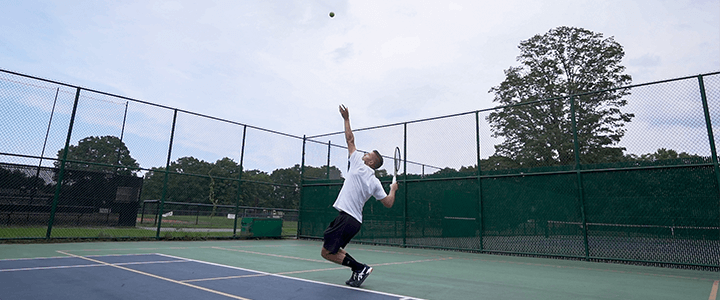
On serve, the Blade offers a bit of surprise.
As you might expect, the racquet’s strength on serve is accuracy, which I thought was excellent. However, despite its lower power, I’ve never found the Blade overly lacking on serve.
It’s certainly not the racquet I’d gravitate toward for going all out on my serve. However, I found I can put more into my motion without a significant drop in my consistency.
Add to that plenty of spin for slice and kick serves, and the Wilson Blade is a solid all-around performer in this category.
Returns
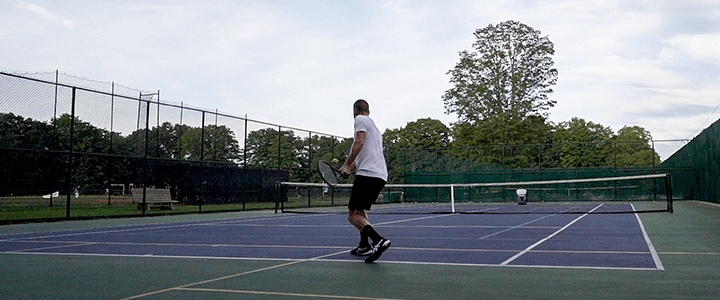
Finally, on returns, I think the Blade is more than adequate.
It can be a bit slow on the backswing and somewhat unforgiving on off-center shots. However, with that said, if you nail your preparation and timing, the frame will reward you.
Its control and lower power allow you to swing through the ball with confidence, and there’s plenty of spin on tap to avoid overhitting, which lends itself to added versatility in your replies.
Summary & Takeaways

Overall, I think Wilson delivers an excellent update to the Blade 98 with an eighth-generation that builds upon the frame’s core DNA, adding subtle refinements that enhance performance.
It’s an excellent, all-court racquet that’s ideal for intermediate to advanced players who have developed sufficient skill and technique to reap the benefits of its lower power and precision. Additionally, it’s an excellent option for players in need of a frame that delivers comfort.
However, newer players, aggressive baseliners, and big hitters who demand maximum spin and easier access to power will likely be disappointed by what this frame brings to the table.
| Wilson Blade Models |
| Wilson Blade 98 v8 16×19 |
| Wilson Blade 98 v8 18×20 |
| Wilson Blade 100 v8 |
| Wilson Blade 100 L v8 |
| Wilson Blade 100 UL v8 |
| Wilson Blade SW102 Autograph |
| Wilson Blade 104 v8 |
Why I Love It
- Control
- Feel
- Comfort
Tradeoffs
- Power
- Maneuverability
- Stability
Strings
I paired the Wilson Blade 98 v8 with one of my favorite polyester tennis strings for my playtest, and I wasn’t disappointed. Here’s a quick reminder of the setup I used.
- String: Luxilon ALU Power
- Gauge: 1.25 mm (16L gauge)
- Tension: 52 lbs (23.6 kg)
The Wilson Blade and Luxilon ALU Power work exceptionally well together. With the smaller 98 square inch head size, I appreciate the higher levels of spin and the complementary feel the string offers.
With that said, it won’t be ideal for all players. For example, one of the biggest drawbacks of the two is power. You get loads of control, but the lack of energy return can present an issue and cause players to overhit, which can be taxing and lead to unforced errors.
Regarding gauge, I usually string most strings, including polys, thicker for added durability. However, if you’re a string breaker like me, I do think you can get away with a size down from what you typically use. For me, that would be bumping down to 16L or 1.25 mm.
I enjoyed the tension I selected, but if you’re looking for a bit of extra pop, then you’ll likely appreciate dropping 2 – 4 lbs or 0.91 – 1.81 kg.
As for comfort, many players struggle with full poly setups. However, I think most will do well with a full poly due to the racquet’s generous flex, especially if you’re stringing thinner and at a lower tension.
I recognize Luxilon ALU Power is an expensive tennis string, and players will look for alternatives. With that in mind, here are a few that will complement the Wilson Blade 98 v8 nicely.
All of the above strings are polyester, which I do think is ideal for this frame. However, if comfort is a concern, you might also consider a hybrid string setup, combining a poly and multifilament or gut.
Alternatively, you could skip the hybrid and opt for control-oriented multifilament, which would yield a similar result with less spin.
Wilson Blade 98 16×19 v8 Alternatives

If you find the Wilson Blade 98 v8 appealing, but you’re still in research mode and considering other frames, then there are a handful of additional racquets within the same vein you might want to consider.
Below I’ve shared my shortlist of racquets and how they stack up relative to the Blade when it comes to performance.
Wilson Blade 18×20

If you’re in the market for a Wilson Blade, you may be wondering whether or not you should opt for the 16×19 or 18×20 string pattern.
Both are excellent racquets that come with identical specs, except for the string pattern, so many players get hung up on which path they should take or ask if one is better than the other.
Before you decide, it’s helpful to consider the difference between an open string pattern and a closed string pattern. Here’s a quick comparison outlining the differences.
| Open Pattern (16×19) | Closed Pattern (18×20) |
| Added Power | Added Control |
| Extra Spin | Extra Precision |
| Less Firm | More Firm |
| Higher Shot Trajectory | Lower Shot Trajectory |
To decide which is better for you, it helps to consider your style of play. If you’re an aggressive baseliner that likes to hit with lots of spin, then you’ll most likely gravitate toward the 16×19.
However, if you hit a bit flatter and like to spend as much time up at net as you do on the baseline, then the 18×20 might be ideal.
If you’re like many players, you may feel like you fall somewhere in between, so a demo of both would likely help you make the call. Otherwise, you can determine if your game slants toward one of the two above buckets and go with that option.
| Strung Specs | Blade v8 16×18 | Blade 98 v8 18×20 |
| Length | 27in / 68.58cm | 27in / 69cm |
| Head Size | 98 in² / 632.26 cm² | 98 in² / 632.26 cm² |
| String Pattern | 16×19 | 18×20 |
| Strung Balance | 5pts HL | 5pts HL |
| Weight | 11.4oz / 323g | 11.4oz / 323g |
| Swingweight | 320 | 320 |
| Beam | 21mm / 21mm / 21mm | 21mm / 21mm / 21mm |
| Stiffness | 61 | 61 |
Wilson Pro Staff 97 v13

Before jumping to other brands, the Wilson Pro Staff 97 v13 is a worthy alternative that might be an ideal fit.
Both racquets offer a classic feel, but the heavier Pro Staff’s thicker beam and braided graphite and Kevlar construction are a bit stiffer, which translates to added feedback and a bit of extra power.
The frame also stores more of its weight down in the handle for a more HL balance but retains stability through its construction and adding weight at three and nine o’clock on the frame’s head.
It’s an excellent frame that caters to a very similar audience but delivers an entirely different feel that might be up your alley.
| Strung Specs | Blade v8 16×19 | Pro Staff 97 v13 |
| Length | 27in / 68.58cm | 27in / 69cm |
| Head Size | 98 in² / 632.26 cm² | 97 in² / 625.81 cm² |
| String Pattern | 16×19 | 16×19 |
| Strung Balance | 5pts HL | 7pts HL |
| Weight | 11.4oz / 323g | 11.7oz / 332g |
| Swingweight | 320 | 321 |
| Beam | 21mm / 21mm / 21mm | 21.5mm / 21.5mm / 21.5mm |
| Stiffness | 61 | 66 |
Babolat Pure Strike 16×19 3rd Gen
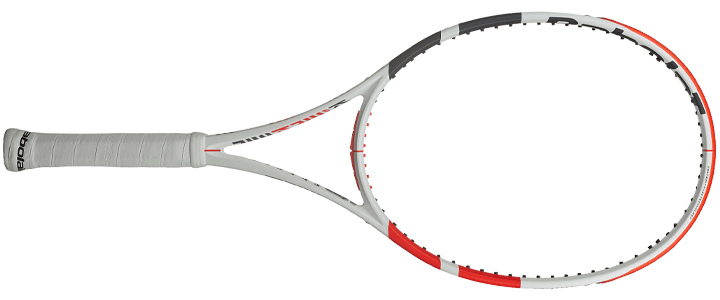
One of my top picks for the best tennis racquets in 2022 and years past is the Babolat Pure Strike.
Like the Wilson Blade, it features a control-centric 98 square inch head size but packs extra power and spin with a thicker beam and higher stiffness or RA rating of 66.
The Pure Strike won’t offer the same forgiving feel and comfort you’ll find with the Blade, but it’s by no means harsh and delivers an excellent all-court performance that’s comparable.
| Strung Specs | Blade v8 16×19 | Pure Strike 3rd Gen |
| Length | 27in / 68.58cm | 27in / 69cm |
| Head Size | 98 in² / 632.26 cm² | 98 in² / 632.26 cm² |
| String Pattern | 16×19 | 16×19 |
| Strung Balance | 5pts HL | 4pts HL |
| Weight | 11.4oz / 323g | 11.4oz / 323g |
| Swingweight | 320 | 327 |
| Beam | 21mm / 21mm / 21mm | 21mm / 23mm / 21mm |
| Stiffness | 61 | 66 |
Yonex EZONE 98
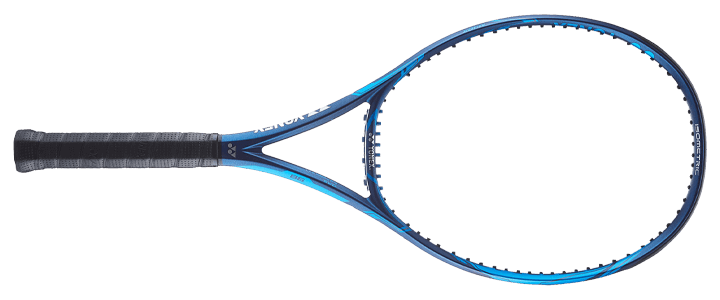
Another excellent frame that’s a crowd favorite and easy to recommend is the Yonex EZONE 98.
Like the Pure Strike, I find it offers a bit more power and spin than the Wilson Blade, but it’s somewhere in the middle.
It’s a bit on the lighter side at only 11.3 oz (320g) strung and stores a bit more weight in the handle compared to the Blade, so many players will find it more maneuverable but less stable.
If weight is at all a concern with the Blade, it’s a solid alternative.
| Strung Specs | Blade v8 16×19 | EZONE 98 |
| Length | 27in / 68.58cm | 27in / 69cm |
| Head Size | 98 in² / 632.26 cm² | 98 in² / 632.26 cm² |
| String Pattern | 16×19 | 116×19 |
| Strung Balance | 5pts HL | 6pts HL |
| Weight | 11.4oz / 323g | 11.3oz / 320g |
| Swingweight | 320 | 320 |
| Beam | 21mm / 21mm / 21mm | 23mm / 24mm / 19mm |
| Stiffness | 61 | 64 |
Tecnifibre TFight 300 RS
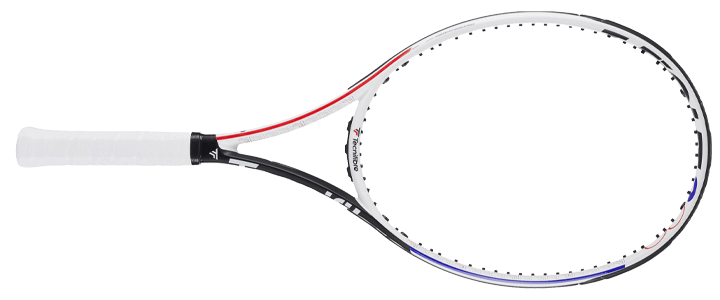
Finally, another frame I’d recommend as an alternative is the Tecnifibre TFight 300 RS, which boasts similar specs to the Wilson Blade 98 v8.
Once again, like the others I’ve listed, this frame will pack a bit more punch due to its higher stiffness and thicker beam, but it’s also going to come in a bit lighter at 11.2 oz (318g) strung.
It won’t offer quite as much comfort as the Blade, but it’s another excellent option that delivers solid all-around performance.
| Strung Specs | Blade v8 16×19 | TFight 305 RS |
| Length | 27in / 68.58cm | 27in / 69cm |
| Head Size | 98 in² / 632.26 cm² | 98 in² / 632.26 cm² |
| String Pattern | 16×19 | 16×19 |
| Strung Balance | 5pts HL | 4pts HL |
| Weight | 11.4oz / 323g | 11.2oz / 318g |
| Swingweight | 320 | 320 |
| Beam | 21mm / 21mm / 21mm | 23mm / 23mm / 22.5mm |
| Stiffness | 61 | 66 |
Wrapping Up
New for 2021, the Wilson Blade 98 v8 retains the key ingredients that have helped make it one of the best-selling tennis racquets while incorporating a handful of refinements for optimal performance.
Whether you’re interested in buying a Wilson Blade for the first time or you’re evaluating the eighth generation as an upgrade, I hope you’ve found what I’ve shared in this review and guide helpful.
Of course, if you have any questions, please don’t hesitate to post a comment in the following section.
Play Better Tennis
Improve your game alongside our community of tennis players
Why join?
Discussion Boards
Join the conversation with other members of the community.
5 Point Friday
Read our weekly recap of the 5 most interesting things we dig up in tennis.



Leave a Reply
Want to join the discussion?Feel free to contribute!